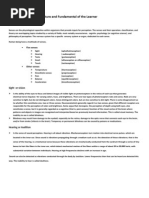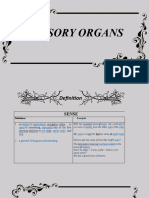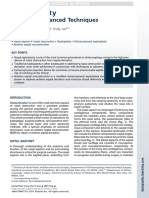Sensory Stimulation
Sensory Stimulation
Uploaded by
KarlBalmeraCopyright:
Available Formats
Sensory Stimulation
Sensory Stimulation
Uploaded by
KarlBalmeraOriginal Description:
Copyright
Available Formats
Share this document
Did you find this document useful?
Is this content inappropriate?
Copyright:
Available Formats
Sensory Stimulation
Sensory Stimulation
Uploaded by
KarlBalmeraCopyright:
Available Formats
Sensory Stimulation Therapy
definition of terms:
Sensory Stimulation a form of psychotherapy to test the persons sense of awareness on
specific objects utilizing the five (5) senses.
Therapist a person trained in the use of psychological methods for helping patients
overcome psychological problems.
Client - a person who is receiving the benefits, services, etc., of a social welfare agency, a
government, bureau.
Hallucination a false sensory perceptions or perceptual experience that do not really exist.
Hallucinations can involve the five senses and bodily sensations.
Most common:
Auditory hallucinations: hearing voices
Visual hallucinations: see things that that dont really exist
Illusions a distortion of the senses, revealing how the brain is normally organizes and
interprets sensory stimulation.
Delusion a fixed false belief not based in reality
Special body senses:
The senses connect humans to the real world, allowing them to interpret what is
happening around them and respond accordingly. The color of the sky at dusk, the
sound of laughter at a party, the scent of eucalyptus and pine, the taste of freshly
baked breadall would be meaningless without the senses. They not only provide
pleasure, but warn of danger.
a) Sense of sight - vision is the capability of the eye(s) to focus and detect images of visible
light on photoreceptors in the retina of each eye that generates electrical nerve impulses for
varying color and brightness.
example: 2 opposing colors(black and white)
b) Sense of smell - Smell, called olfaction, is the ability of an organism to sense and identify a
substance by detecting tiny amounts of the substance that evaporate and produce an odor.
Smell is the most important sense for most organisms.
example: pleasant and unpleasant odor
c.) Sense of hearing - The human ear is the organ responsible for hearing and for equilibrium
or balance.
Example: soft sound and loud sound
d.) Sense of touch - a perception resulting from activation of neural receptors, generally in the
skin including hair follicles, but also in the tongue, throat, and mucosa.
Example: soft and hard, smooth and rough
e.) Sense of taste - is one of the traditional five senses. It refers to the capability to detect the
taste of substances such as food, certain minerals, and poisons, etc. The sense of taste is often
confused with the "sense" of flavor, which is a combination of taste and smell perception.
Example: sweet, sour, bitter, salty taste
Purposes of sensory stimulation
- reinforce reality
- maintain contact with reality
- establish awareness on the patient
- test the acuity of the patient different senses
- to promote relaxation
- to encourage positive behavior and emotion
You might also like
- Sense Organ PDFDocument5 pagesSense Organ PDFPerry Sin67% (6)
- Sensory Deprivation NewDocument19 pagesSensory Deprivation NewSREEDEVI T SURESHNo ratings yet
- Sex and SensesDocument1 pageSex and SensesEmie EmbalsadoNo ratings yet
- Psychodynamic Perspective:: How Strong A Stimulus To Be Detected?Document5 pagesPsychodynamic Perspective:: How Strong A Stimulus To Be Detected?Lyanna MormontNo ratings yet
- Sensation ProcessesDocument19 pagesSensation Processesehtasham asifNo ratings yet
- Class 5 PPT On Human Sense OrganDocument16 pagesClass 5 PPT On Human Sense OrganGizaw TadesseNo ratings yet
- Sensory ProcessDocument18 pagesSensory ProcessIrfan Ul HaqNo ratings yet
- Science Form 3 Stimuli and Responses in HumansDocument6 pagesScience Form 3 Stimuli and Responses in HumansSharvin JananeeNo ratings yet
- Sensation and PerceptionDocument2 pagesSensation and PerceptionBagi Racelis0% (1)
- Five SensesDocument41 pagesFive SensesJobel Sibal CapunfuerzaNo ratings yet
- Types of Perception (OB)Document10 pagesTypes of Perception (OB)Ankita GaikwadNo ratings yet
- Sense OrgansDocument9 pagesSense OrgansЕкатерина КовальNo ratings yet
- 4. Sensation PresentationDocument16 pages4. Sensation PresentationahaanrayyanNo ratings yet
- SensationDocument4 pagesSensationMaitreyi DasNo ratings yet
- Sense OrganDocument14 pagesSense OrganAna Concepcion IsraelNo ratings yet
- 2 HVCDocument18 pages2 HVCjadhavjaysurya3No ratings yet
- Sensation and PerceptionDocument89 pagesSensation and PerceptionAarush JainNo ratings yet
- SensationDocument5 pagesSensationAndalNo ratings yet
- GenpsyDocument27 pagesGenpsyGerlyn BrionesNo ratings yet
- Assignment-3: Sensation: Sensation in Psychology Is Any Concrete, Conscious ExperienceDocument13 pagesAssignment-3: Sensation: Sensation in Psychology Is Any Concrete, Conscious ExperienceHimanshi ShokeenNo ratings yet
- SensationDocument19 pagesSensationJohn bryan DuranNo ratings yet
- The Nature and Fundamental of The Learner Sensation: Abigail Salazar BPE III-3Document5 pagesThe Nature and Fundamental of The Learner Sensation: Abigail Salazar BPE III-3Ernielle Clark DionisioNo ratings yet
- BMS 200 Assignment 1 Lillian Mohambi October 2021Document6 pagesBMS 200 Assignment 1 Lillian Mohambi October 2021lillyNo ratings yet
- Sensory Organs: What Are The Sense Organs?Document3 pagesSensory Organs: What Are The Sense Organs?ajay kalangiNo ratings yet
- Sensation and PerceptionDocument36 pagesSensation and Perceptionshreya.karNo ratings yet
- Sense: Pietro PaoliniDocument34 pagesSense: Pietro PaolinisameshNo ratings yet
- The World Through Our Senses: Form Two Science, Chapter OneDocument10 pagesThe World Through Our Senses: Form Two Science, Chapter Onegan tong hock a.k.a ganosNo ratings yet
- Sensory OrgansDocument11 pagesSensory OrgansVictoria VintuNo ratings yet
- Sense OrganDocument2 pagesSense Organhatanda39No ratings yet
- YihalemDocument16 pagesYihalemyihalemasmamawNo ratings yet
- 5 SensesDocument1 page5 SensespsathishthevanNo ratings yet
- Science Form 2Document9 pagesScience Form 2yvonne vonne vonneNo ratings yet
- PsychologyDocument23 pagesPsychologyifedejoshua530No ratings yet
- 2.1 Sensory and Perceptual ProcessingDocument5 pages2.1 Sensory and Perceptual ProcessingNayak Prem KiranNo ratings yet
- The Five Senses & Their FunctionsDocument11 pagesThe Five Senses & Their FunctionsCherry Anne Castillejos100% (1)
- Sensation & PerceptionDocument55 pagesSensation & PerceptionMary James100% (1)
- Identifikasi Jurnal - Facebook Profiles Reflect Actual Personality, Not Self-IdealizationDocument6 pagesIdentifikasi Jurnal - Facebook Profiles Reflect Actual Personality, Not Self-IdealizationFika_nNo ratings yet
- Sensation (2)Document11 pagesSensation (2)lokendrabhandari000000No ratings yet
- Name - M Ervyn Chah: Class - 2 S EtiaDocument20 pagesName - M Ervyn Chah: Class - 2 S EtiaB Ching TanNo ratings yet
- Sensation 1Document6 pagesSensation 1SteamNo ratings yet
- IMP QNA pschoDocument31 pagesIMP QNA pschoPALAK SHARMANo ratings yet
- Sensation, Perception, Attention PsychologyDocument9 pagesSensation, Perception, Attention PsychologyFida AhmedNo ratings yet
- Sexual Sense 1Document21 pagesSexual Sense 1axljakebarcancel5No ratings yet
- Anatomy and Structure of Human Sense OrgansDocument6 pagesAnatomy and Structure of Human Sense OrgansBonjovi VerdejoNo ratings yet
- Sensation and PerceptionDocument5 pagesSensation and PerceptionJovelyn ZambranoNo ratings yet
- Is Your Skin, Nose, Tongue, Ears, and Eyes Right? I. ObjectivesDocument11 pagesIs Your Skin, Nose, Tongue, Ears, and Eyes Right? I. ObjectivesHafizah Ghany HayudinnaNo ratings yet
- SensationDocument6 pagesSensationIzhar KhanNo ratings yet
- General Psychology AssignmentDocument4 pagesGeneral Psychology AssignmentSaaB PanaraagNo ratings yet
- What Is Sensory Processes: 1.absolute ThresholdsDocument4 pagesWhat Is Sensory Processes: 1.absolute ThresholdslucasNo ratings yet
- 6 - SensationDocument28 pages6 - SensationNismaNo ratings yet
- Laporan SenseDocument16 pagesLaporan SenseladylomoNo ratings yet
- Sense Organs Notes ICSEDocument2 pagesSense Organs Notes ICSEwinispassionNo ratings yet
- Special SensesDocument5 pagesSpecial SensesFlorence AlvarezNo ratings yet
- Unit 3: Sensation and PerceptionDocument235 pagesUnit 3: Sensation and PerceptionShanti DumreNo ratings yet
- Sense-of-touchDocument16 pagesSense-of-touchjayson.da.nurseNo ratings yet
- Sensory OrganDocument20 pagesSensory OrganJaneNo ratings yet
- Pathology of Perception-1Document32 pagesPathology of Perception-1KoushikNo ratings yet
- SensationDocument11 pagesSensationMuzameelAshrafNo ratings yet
- Sensasi Dan PersepsiDocument19 pagesSensasi Dan PersepsiRandy Hidayat DompasNo ratings yet
- Dato' DR Sirajuddin For CB - Amd - v1Document29 pagesDato' DR Sirajuddin For CB - Amd - v1Ayda Ansah50% (2)
- Clinical Practicum II ProposalDocument30 pagesClinical Practicum II Proposalapi-281813422No ratings yet
- Today's Catholic Print Edition: Black History Month 2023 Spotlights Healthcare Hero Dr. Leo EdwardsDocument2 pagesToday's Catholic Print Edition: Black History Month 2023 Spotlights Healthcare Hero Dr. Leo EdwardsBrittany LudwigNo ratings yet
- Alteration in OxygenationDocument8 pagesAlteration in Oxygenationraquel maniegoNo ratings yet
- CHAPTER 3 HorticultureDocument36 pagesCHAPTER 3 HorticultureTaimur Hyat-KhanNo ratings yet
- Metbio Trainingdoc Bece209928 01-09-2009Document19 pagesMetbio Trainingdoc Bece209928 01-09-2009Jessica Joselyn Rojas BenavidesNo ratings yet
- Most2017 SEPTODocument9 pagesMost2017 SEPTOJhoel L BenitezNo ratings yet
- Effective Doctor-Patient Communication-Ahitoramyth?Document2 pagesEffective Doctor-Patient Communication-Ahitoramyth?sonyNo ratings yet
- WarfarinDocument4 pagesWarfarinekramNo ratings yet
- Alumnus - Vol.45 #3Document4 pagesAlumnus - Vol.45 #3National University of Health SciencesNo ratings yet
- Anita Williams - Footwear and Foot OrthosesDocument169 pagesAnita Williams - Footwear and Foot OrthosesRukaphuong100% (1)
- MC CPHS P 17 Drug SamplesDocument5 pagesMC CPHS P 17 Drug SamplesjooorysfNo ratings yet
- Revised MGT 210-NOVARTIS Final ReportDocument21 pagesRevised MGT 210-NOVARTIS Final Reportkazi saadNo ratings yet
- DRRR L1Document1 pageDRRR L1Dainielle Marie PascualNo ratings yet
- Dynamic of Philippines GovernmentDocument12 pagesDynamic of Philippines GovernmentDuay Guadalupe VillaestivaNo ratings yet
- Get Ready PT3 English Form 2 (P1)Document23 pagesGet Ready PT3 English Form 2 (P1)OMAR SHAH50% (2)
- RCRubina Brief Profile 2013Document2 pagesRCRubina Brief Profile 2013Robin RubinaNo ratings yet
- Final Project DaburDocument78 pagesFinal Project DaburRohit KapoorNo ratings yet
- ADP Payroll Detail Manual v4 PDFDocument21 pagesADP Payroll Detail Manual v4 PDFchakripsNo ratings yet
- Ubalozi Wa Marekani Dar Es Salaam: TanzaniaDocument9 pagesUbalozi Wa Marekani Dar Es Salaam: Tanzaniakhalfan saidNo ratings yet
- Icd 10Document54 pagesIcd 10gexchaNo ratings yet
- Marketing Report: Unilever's LifebuoyDocument11 pagesMarketing Report: Unilever's LifebuoydolapoNo ratings yet
- Nutrition and The LiverDocument72 pagesNutrition and The LiveranggiNo ratings yet
- Environmental Acts and RulesDocument10 pagesEnvironmental Acts and RulesShivay NegiNo ratings yet
- First Periodical Test Sci 9Document4 pagesFirst Periodical Test Sci 9Jhaypee Soriano100% (1)
- Characterizing The Structural Integrity Of.32Document11 pagesCharacterizing The Structural Integrity Of.32Alejo ZambranoNo ratings yet
- Household Survey Form 2Document6 pagesHousehold Survey Form 2JAYNE NICOLE M. MOTILLA (Warka)No ratings yet
- Medical Clinics PresentationDocument26 pagesMedical Clinics PresentationCurry 30No ratings yet
- TDS - Mastertile 530 - RbgroutDocument1 pageTDS - Mastertile 530 - RbgroutVenkata RaoNo ratings yet
- Department of Pharmacy Practice Sultan Ul Uloom College of Pharmacy (Approved by AICTE & PCI, A Liated To JNTUH) Mount Pleasant, Road No.3, Banjara Hills, Hyderabad 500 034Document14 pagesDepartment of Pharmacy Practice Sultan Ul Uloom College of Pharmacy (Approved by AICTE & PCI, A Liated To JNTUH) Mount Pleasant, Road No.3, Banjara Hills, Hyderabad 500 034sufiya fatimaNo ratings yet

























































































